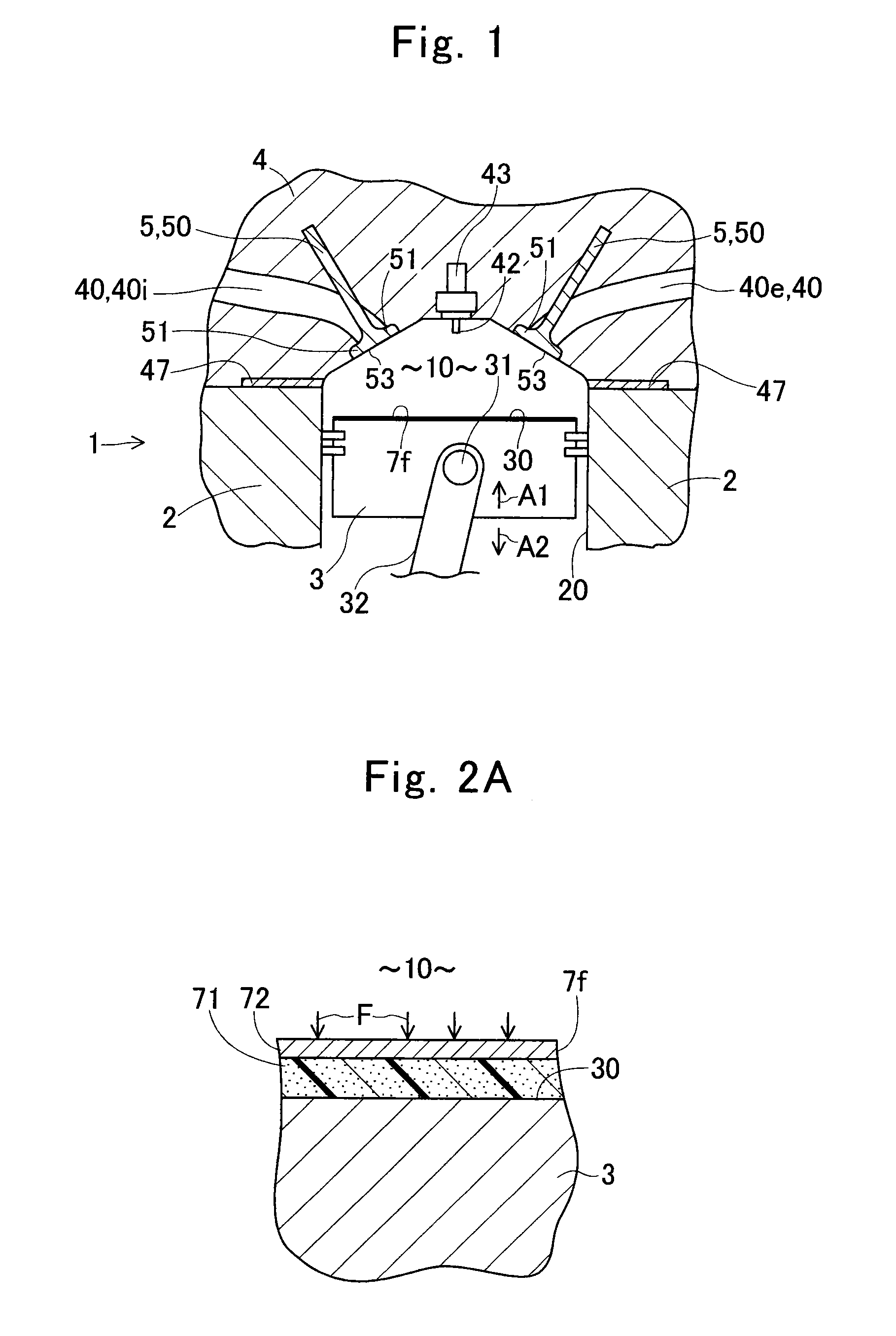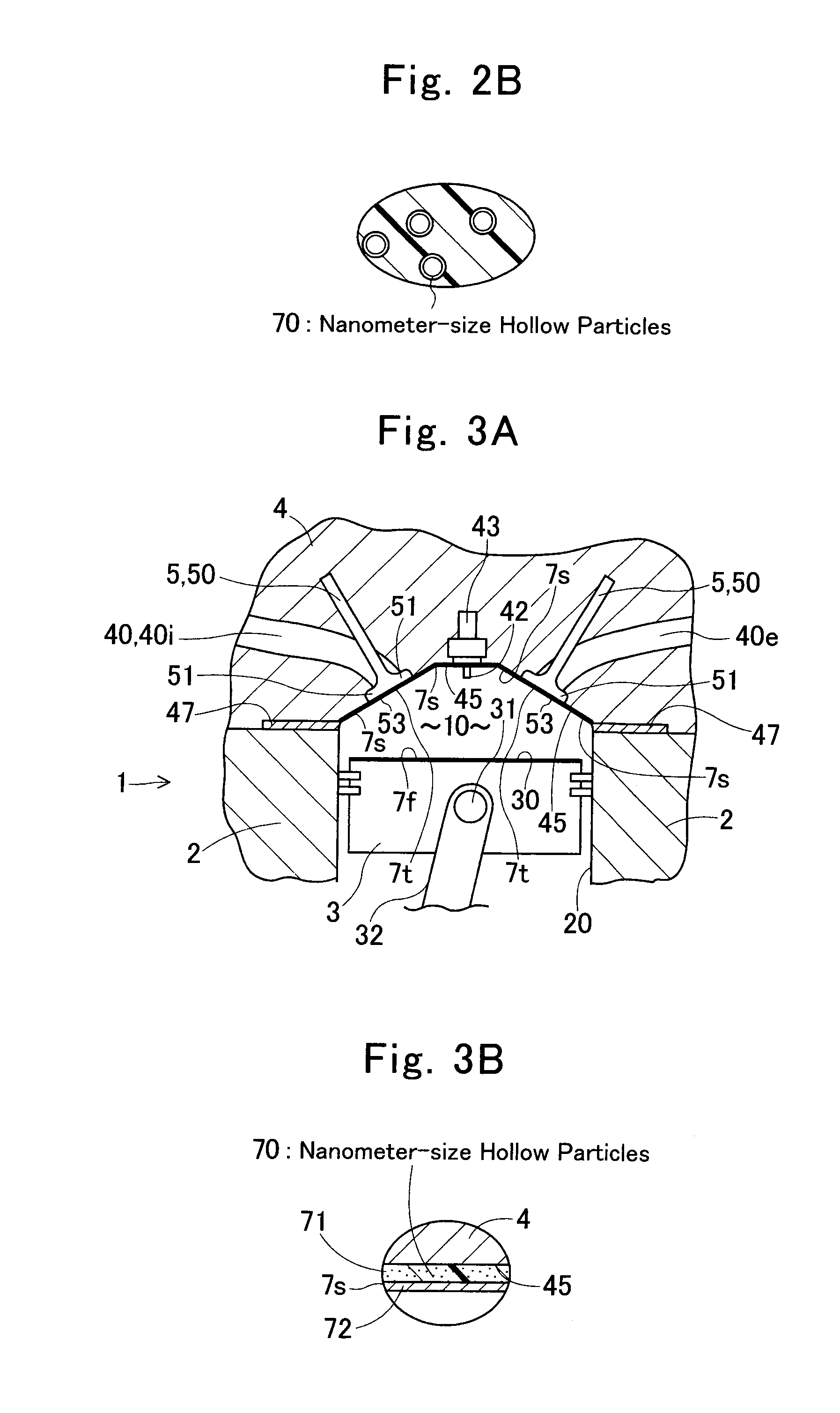Engine and piston
a technology applied in the field of engine and piston, can solve the problems of affecting the efficiency of engine upgrading, so as to enhance the heat-insulating property of the combustion chamber, improve the heat-insulating property, and improve the surface flatness/smoothness
- Summary
- Abstract
- Description
- Claims
- Application Information
AI Technical Summary
Benefits of technology
Problems solved by technology
Method used
Image
Examples
third embodiment
Mode
[0113]Since the present embodiment mode comprises the same constituents as those of First and Second Embodiment Modes basically, and operates and effects advantages in the same manner as they do, it can be described with reference to FIG. 1 through FIG. 3C. A first heat-insulation coating film 7f is formed on a top face 30, one of the wall faces of a piston 3 disposed face-to-face to the combustion chamber 10. Moreover, a second heat-insulation coating film 7s is formed on a wall face 45, one of the wall faces of a cylinder head 4 disposed face-to-face to the combustion chamber 10. Besides, a third heat-insulation coating film 7t is formed also on a valve face 53, one of the wall faces of valves 5 disposed face-to-face to the combustion chamber 10. Thus, the first heat-insulation coating film 7f is formed on the top face 30 disposed face-to-face to the combustion chamber 10; the second heat-insulation coating film 7s is formed on the wall face 45, one of the wall faces of the cy...
fourth embodiment
Mode
[0115]Since the present embodiment mode comprises the same constituents as those of First through Third Embodiment Modes basically, and operates and effects advantages in the same manner as they do, it can be described with reference to FIG. 1 through FIG. 3C. A first heat-insulation coating film 7f is formed on a top face 30, one of the wall faces of a piston 3 disposed face-to-face to the combustion chamber 10, although it is not shown in the drawings. Moreover, a second heat-insulation coating film 7s is formed on a wall face 45, one of the wall faces of a cylinder head 4 disposed face-to-face to the combustion chamber 10. Consequently, the heat-insulating property of the combustion chamber 10 enhances.
fifth embodiment
Mode
[0116]Since the present embodiment mode comprises the same constituents as those of First through Fourth Embodiment Modes basically, it can be described with reference to FIG. 1 through FIG. 3C. Hollow particles serving as the second nanometer-size hollow particles are included in an inorganic-system coated-film layer 72, although they are not shown in the drawings. The inorganic-system coated-film layer 72 comprises the hollow particles, and silica (i.e., a binder) serving as a metallic compound. When the entirety of the inorganic-system coated-film layer 72 is taken as 100% by volume, a content of the hollow particles is 35% by volume, and a content of the silica is 65% by volume. A thickness of the inorganic-system coated-film layer 72 is 40 μm.
[0117]The hollow particles to be included in the inorganic-system coated-film layer 72 are the same as the nanometer-size hollow particles 70 to be included in the heat-insulative layer 71. That is, the hollow particles to be included ...
PUM
 Login to View More
Login to View More Abstract
Description
Claims
Application Information
 Login to View More
Login to View More - R&D
- Intellectual Property
- Life Sciences
- Materials
- Tech Scout
- Unparalleled Data Quality
- Higher Quality Content
- 60% Fewer Hallucinations
Browse by: Latest US Patents, China's latest patents, Technical Efficacy Thesaurus, Application Domain, Technology Topic, Popular Technical Reports.
© 2025 PatSnap. All rights reserved.Legal|Privacy policy|Modern Slavery Act Transparency Statement|Sitemap|About US| Contact US: help@patsnap.com



